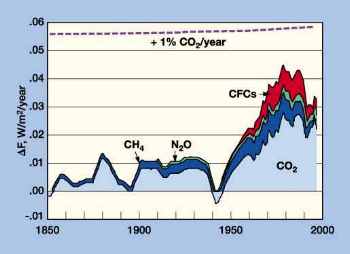What's happening in production
Tired of global warming? Then just say GAGG!Just when you thought the cause(s) of global warming was known, new data from NASA reveal just how complex and muddled the issue is. The jury is still out concerning root cause(s). In a NASA report released in late July, researchers Dr. Roy Spencer and Dr. John Christy are trying to account for unexpected temperature patterns recently discovered within the atmosphere. These patterns, taken from satellite and radiosonde data during the last 21 years, show that: the Lower Troposphere (< 5 mi) has only warmed slightly, much less than the surface; the Upper Troposphere (5 – 8 mi) shows greater warming; while the Lower Stratosphere (8 – 12 mi) is cooling. This is contrary to what computer models say should occur. "I think it points out that the atmosphere is more complex than computer models currently simulate," said Spencer. In trying to reconcile discrepancies between the models and reality, the heat-island effect was mentioned (i.e., maybe the Earth isn’t warming as much as we thought), as was the ozone layer.
Heat-island effect. Some scientists suspect that surface-temperature records have been exaggerated by proximity to metropolitan areas, since thermometers are usually located in areas easily accessible and, in industrial countries, are most often found at airports. Spencer said, "I believe there are still urban warming biases in the global thermometer record that are exaggerating the global-warming signal. I don’t think it will be possible to remove these biases since virtually all thermometer sites have experienced changes in their microclimate due to [human] activities." However, Spencer also pointed out that the above findings ". . . do not substantially alter the expectation that some amount of global warming will occur in the future." Ozone ups and downs. In another report in June of this year, NASA announced that those of us who paid extra for Freon substitutes and non-CFC-ridden Styrofoam, etc., – "your efforts may be paying off." Researchers for the agency said that they were beginning to see a turnaround in the amount of ozone-destroying chemicals in the upper atmosphere. Part of the optimism was because the Antarctic ozone hole was smaller in October 1999 than it was in October 1998. However, by September 8th, NASA announced that the ozone hole had grown to a new record of 28.3 million sq km – about three times larger than the U.S. landmass. Yet another NASA report, Culprits of Climate Change, by Dr. James Hansen of the Goddard Institute for Space Studies, supports the notion that climate has been altered by human activities, but says that climate change in recent decades has been mainly caused by air pollution containing non-CO2 greenhouse gases. The report states that, in recent decades, air pollution containing non-CO2 greenhouse gases – particularly tropospheric ozone, methane, chlorofluorocarbons (CFCs) and soot particles – are the main culprits (see figure). "The good news is that the growth rate of non-CO2 greenhouse gases has declined in the past decade, and if sources of methane and tropospheric ozone were reduced in the future, further changes in climate due to these gases in the next 50 years could be near zero," Hansen explained. "If these reductions were coupled with a reduction in both particles of black carbon and CO2 emissions, this could lead to a decline in the rate of climate change." This editor’s view. It seems that just by naming the phenomena "global warming" causes disagreement; it sounds akin to predicting the weather – something we’re lousy at forecasting a few days in advance, let alone decades. But there is a much better consensus that atmospheric composition has changed, particularly with respect to greenhouse gases. Therefore, to foster agreement, I propose changing the phrase "global warming" to "Global Anomalies of Greenhouse Gases," or GAGG. Allow me a few more personal observations. First, while scientific reports vary widely or even conflict, try to avoid contempt; recall that this is the normal way that science proceeds – in zigs and zags, over decades. Second, no one seriously thinks that the Kyoto Protocol will be implemented in anything that resembles its original form, if ever. Third, in some ways, the issue of hydrocarbon fuels as a root cause is irrelevant. Let me explain. Suppose it was finally agreed that most of the atmospheric methane and CO2 increase derived from volcanoes and rotting tundra – not hydrocarbon use. There would likely be those with enough foresight (or arrogance?) to propose imploding (sealing) some volcanoes or seeding millions of acres of tundra with methane-eating bacteria. But much of the focus would still be on: substituting natural gas for coal or
oil; monetizing flare-, associated- and remote-gas resources; reducing air pollution; creating more-efficient
use of existing resources; furthering alternative energies; and in general, mitigating the dangers between
hydrocarbon importing and exporting nations. These initiatives will advance on their own merits; the Kyoto
Protocol would only hasten them.
|




